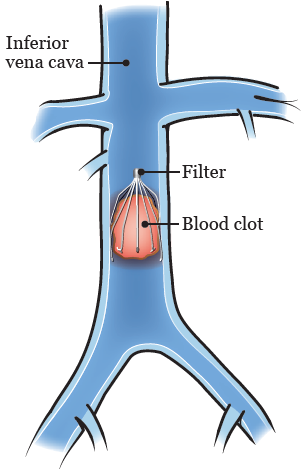This information will help you get ready for your inferior vena cava (IVC) filter placement by the Interventional Radiology Department at Memorial Sloan Kettering (MSK).
About Your IVC Filter

Figure 1. IVC filter
The inferior vena cava is the largest vein in your body. It carries blood from your lower body to your heart and lungs.
A blood clot in a vein below your heart blocks your normal blood flow and may cause swelling, redness, and pain in the area. Blood clots are treated with blood thinners but some people may not be able to receive this treatment. In those cases, an IVC filter may be placed
An IVC filter is a small device that is placed in your inferior vena cava to prevent blood clots from moving through your blood into your lungs (see Figure 1).
Your IVC filter will be placed by your interventional radiologist. An interventional radiologist is a doctor who specializes in image-guided procedures. They will place the IVC filter in your inferior vena cava by going through a vein in your neck or groin. Your doctor will position the IVC filter in the vein using a fluoroscopy (real-time x-rays).
The procedure will take about 30 minutes, but you should expect to be in the procedure room for about an hour. You’ll have a follow-up appointment 4 to 6 weeks after placement to see when your IVC filter can be removed.
Before Your Procedure
Ask about your medicines
You may need to stop taking some of your medicines before your procedure. Talk with your healthcare provider about which medicines are safe for you to stop taking. We’ve included some common examples below.
Blood thinners
Blood thinners are medicines that affect the way your blood clots. If you take blood thinners, ask the healthcare provider performing your procedure what to do. They may recommend you stop taking the medicine. This will depend on the type of procedure you’re having and the reason you’re taking blood thinners.
Examples of common blood thinners are listed below. There are others, so be sure your care team knows all the medicine you take. Do not stop taking your blood thinner without talking with a member of your care team.
|
|
Read How To Check if a Medicine or Supplement Has Aspirin, Other NSAIDs, Vitamin E, or Fish Oil. It has information about medicines you must avoid before your procedure.
Medicines for diabetes
Before your procedure, talk with the healthcare provider who prescribes your insulin or other medicine for diabetes. They may need to change the dose of the medicine you take for diabetes. Ask them what you should do the morning of your procedure.
Your care team will check your blood sugar levels during your procedure.
Diuretics (water pills)
A diuretic is a medicine that makes you urinate (pee) more often. Hydrochlorothiazide (Microzide®) and furosemide (Lasix®) are common diuretics.
If you take any diuretics, ask the healthcare provider doing your procedure what to do. You may need to stop taking them the day of your procedure.
Contrast dye
Contrast is a special dye that makes it easier for your doctor to see differences in your internal organs. This procedure is usually done with contrast. If you’ve had a reaction to contrast in the past, tell your healthcare provider.
If you’re breastfeeding, you may choose to continue after your procedure with contrast. If you have questions or would like to discuss contrast and breastfeeding, talk with your radiologist on the day of your procedure.
Take devices off your skin
You may wear certain devices on your skin. Before your scan or procedure, device makers recommend you take off your:
- Continuous glucose monitor (CGM)
- Insulin pump
Talk with your healthcare provider about scheduling your appointment closer to the date you need to change your device. Make sure you have an extra device with you to put on after your scan or procedure.
You may not be sure how to manage your glucose while your device is off. If so, before your appointment, talk with the healthcare provider who manages your diabetes care.
Arrange for someone to take you home
You must have a responsible care partner take you home after your procedure. A responsible care partner is someone who can help you get home safely. They should be able to contact your care team if they have any concerns. Make sure to plan this before the day of your procedure.
If you don’t have a responsible care partner to take you home, call one of the agencies below. They’ll send someone to go home with you. There’s a charge for this service, and you’ll need to provide transportation. It’s OK to use a taxi or car service, but you still need a responsible care partner with you.
| Agencies in New York | Agencies in New Jersey |
| VNS Health: 888-735-8913 | Caring People: 877-227-4649 |
| Caring People: 877-227-4649 |
Tell us if you’re sick
If you get sick (including having a fever, cold, sore throat, or flu) before your procedure, call your IR doctor. You can reach them Monday through Friday from to
After , during the weekend, and on holidays, call 212-639-2000. Ask for the Interventional Radiology fellow on call.
Note the time of your appointment
A staff member will call you 2 business days before your procedure. If your procedure is scheduled for a Monday, they’ll call you on the Thursday before. They’ll tell you what time to get to the hospital for your procedure. They will also remind you where to go.
If you don’t get a call by noon (12 p.m.) on the business day before your procedure, call 646-677-7001. If you need to cancel your procedure for any reason, call the healthcare provider who scheduled it for you.
The Day Before Your Procedure
Instructions for eating and drinking: 8 hours before your arrival time
|
The Day of Your Procedure
Instructions for drinking: 2 hours before your arrival time
| Stop drinking 2 hours before your arrival time. This includes water. |
Things to remember
- Take only the medications your doctor told you to take the morning of your procedure. Take them with a few sips of water.
- Don’t apply cream or petroleum jelly (Vaseline®). You can use deodorant and moisturizers. Don’t wear eye make-up.
- Remove any jewelry, including body piercings.
- Leave all valuables, such as credit cards and jewelry, at home.
- If you wear contact lenses, wear your glasses instead, if possible. If you don’t have glasses, please bring a case for your contacts.
- Wear loose, comfortable clothing.
What to bring with you
- A list of the medications you take at home.
- Medications for breathing problems (such as inhalers), and medications for chest pain, if you take any.
- A case for your glasses or contacts.
- Your Health Care Proxy form, if you have completed one.
- If you use a CPAP or BiPAP machine to sleep at night, please bring your machine with you, if possible. If you can’t bring your machine with you, we will give you one to use while you’re in the hospital.
- A small pillow or towel to make you feel more comfortable on your way home from the hospital.
What to expect
Once you arrive, doctors, nurses, and other staff members will ask you to state and spell your name and date of birth many times. This is for your safety. People with the same or similar names may be having procedures on the same day.
After changing into a hospital gown, you’ll meet your nurse. They will place an intravenous (IV) catheter into a vein, usually in your hand or arm. At first, you’ll receive fluids through the IV, but it will be used later to give you medication to make you sleepy and more relaxed during your procedure.
Your doctor will explain the procedure, and answer any questions you have. They will also ask you to sign a consent form (a form that says you agree to the procedure and understand the risks).
You’ll be brought into the procedure room and helped onto the table. You’ll lie flat on your back. The skin around your insertion site (your neck or groin) will be cleaned and covered with a drape. You’ll get an injection (shot) to numb the site. Your interventional radiologist will place the IVC filter through a small incision (surgical cut) made in your insertion site.
When the procedure is finished, the site will be cleaned and covered with a bandage.
After Your Procedure
In the recovery room
You’ll be taken to the recovery room or hospital bed. Your nurse will explain your discharge instructions to you and your caregiver before you go home. They’ll also give you a wallet card with information about your IVC filter to keep with you.
Wearing a seatbelt may put pressure on your incisions. You may want to place small pillow or folded towel between the strap and your body when you go home.
At home
Caring for yourself
- Leave the bandage on the insertion site for 24 hours. After 24 hours, you can take it off.
- Your incision may feel sore. This should get better within a day or 2. You can take over-the-counter pain medication, such as acetaminophen (Tylenol®) or ibuprofen (Advil®), if you need it.
- You can shower 24 hours after your procedure.
Activities
- For the first few days, you should avoid certain activities, such as exercises that involve stretching.
- You can still have a magnetic resonance imaging (MRI) while you have an IVC filter, but it’s important to tell the healthcare provider at the radiology facility each time to be safe. Show them the wallet card your nurse gave to you.
- Your IVC filter won’t set off metal detectors.
Follow-Up Appointment
- You’ll have a follow-up appointment with your interventional radiologist about 4 to 6 weeks after your procedure. During this appointment, your doctor will determine whether your IVC filter will be removed.
- After your procedure, call your doctor in Interventional Radiology to schedule an appointment.
When to Call Your Healthcare Provider
Call your healthcare provider if you have any of the following:
- A fever of 100.4° F (38° C) or higher
- Pain around your insertion site that doesn’t go away after taking medication
- Drainage around the incision site
- Redness and swelling around your insertion site

